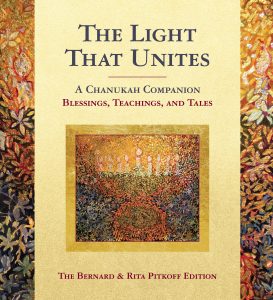Excerpted from The Light That Unites: A Chanukah Companion – Blessings, Teachings, and Tales by Rabbi Aaron Goldscheider
 A Kabbalistic Perspective on the Thirty-Six Candles of Chanukah
A Kabbalistic Perspective on the Thirty-Six Candles of Chanukah
Did you know that the thirty-six candles we light correspond to the thirty-six hours that Adam and Eve lived in the Garden of Eden?
So says Rabbi Tzvi Elimelech of Dinov (1783–1841) in his classic work Bnei Yissaschar. Drawing on Kabbalistic sources, the Rebbe makes the equation between the total of the thirty-six candles that are lit on Chanukah and the thirty-six hours of pure divine light that Adam and Eve experienced in the Garden of Eden, at the very beginning of time.
Jewish tradition teaches us that Adam and Eve were created on the last day of creation, on a Friday. The world they lived in consisted not only of the physical light but also a spiritual light that graced the universe. God’s first words, “Let there be light” (Genesis 1:3), did not refer to the light of the sun or the moon. Rather, the first light created by God was a spiritual light that filled the world with truth and clarity. This unique light was with Adam and Eve for thirty-six hours while they were in the Garden of Eden. When the original man and woman deviated from the path of goodness, that unique light ended. It was left behind in Paradise when they were ordered to leave the Garden, after Shabbat.
The Rebbe of Dinov teaches that the lights we kindle in our homes on Chanukah are reminiscent of the first light that God gave man. From our own small candles, we envision a spark of the divine light. This is a spiritual light that is meant to reveal both holiness in the world and the inner goodness found in all of creation.
It is no coincidence then that both the light of Chanukah and the pure light that was created at the beginning of time share the same number. The lights of Chanukah remind us that the spiritual light that once adorned mankind can be lit up again. We actually pray for this light each day in our daily morning prayers: Ohr chadash al Tzion ta’ir, “May You shine a new light on Zion.”
When Rabbi Shlomo Carlebach shared this teaching from the Dinover Rebbe, he would add the following:
When we stand in front of the holy candles we are reminded that our world can be perfected. We are awakened to dream of a world reminiscent of the Garden of Eden: a place of peace and serenity, a place of kindness and of love.
Do you know what the saddest thing in the world is? When we stop longing for a perfect world.
Chanukah teaches us not be satisfied with a little bit of light, a little bit of good, a little bit of peace…but to passionately desire the most perfect light. We can never allow ourselves to lose sight of a great and lofty vision of what this world could look like. The light of Chanukah reveals to us a light of pure goodness that once filled this world…a light that will surely be revealed again.
In the glow of the menorah we see a glimmer of the original light of creation. This light radiates the signs of the final victory over evil.
We live in a world of hidden light, and it is up to us to repair the world, by righting injustice, by treating everyone and everything with loving compassion, by discerning the divine light at the core of every dark shell.
~~~~~~
In the introduction to his biblical commentary, the Ramban (Nachmanides, 1194–1270) states that everything is to be found within the Torah, either in open or hidden fashion. As an example, he points out that Rabbi Akiva learned thousands of ideas even from the tagin, the crowns that adorn the tops of the letters in a Torah scroll (Talmud, Menachot 29b).
Bearing this in mind, the Bnei Yissaschar indicates that in the phrase “And God saw the light, that it was good” (Genesis 1:4), one finds a hint to the mitzvah of lighting the Chanukah candles. Carefully look at the word tov, “good,” and take note specifically of the tagin, the crown of the letter tet. Usually, this letter, the first letter of the word tov, contains only three tagin, but here it contains four.

The reason for this, he explains, is that the letter tet has the gematria or numerical equivalent of nine. And nine times four equals thirty-six – alluding to the thirty-six lights that are kindled during Chanukah. This allusion appears in the verse that says that “God saw the light, that it was good,” which indicates God’s approval of the establishment of the lights of Chanukah and His love of our performance of the mitzvah of lighting the menorah for all time.

